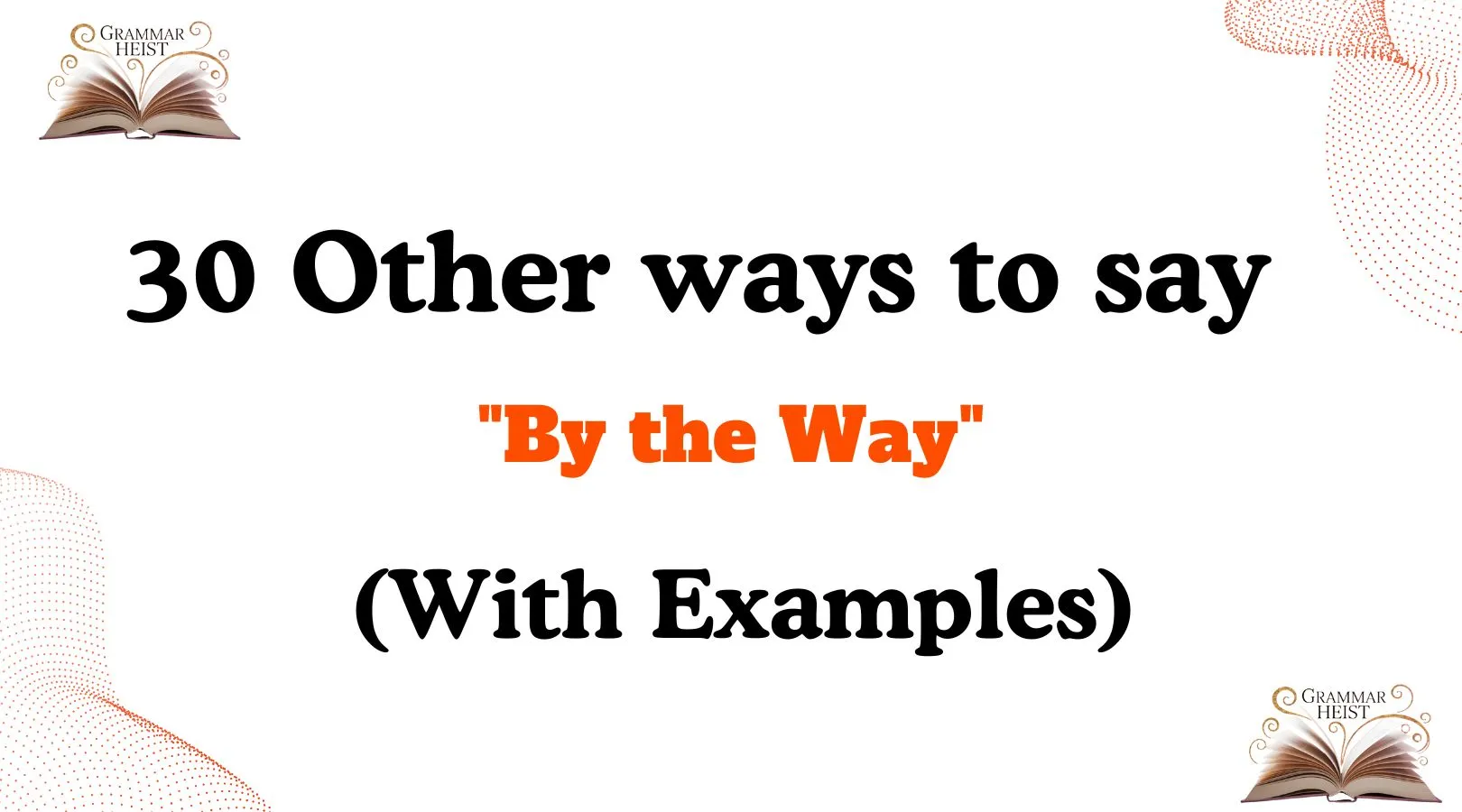In conversation, it’s common to add extra details or provide additional information with phrases like “by the way.” But sometimes, you may want to mix it up and add a bit more personality to your words. Using a variety of expressions can help you keep things fresh and engaging, whether you’re speaking informally with friends or professionally with colleagues. This list of 30 alternatives to “by the way” will help you sound more thoughtful and dynamic in your communication.
Is It Professional/Polite to Say “By the Way”?
“By the way” is a great informal phrase to introduce additional information. In casual conversation, it’s widely accepted and works well to offer extra details or a side note. However, in formal or professional settings, it may sound too casual. In those cases, using one of the alternatives listed below can help you strike a more polished and respectful tone while still conveying the same message.
Pros and Cons
Pros:
- Casual and conversational.
- Helps transition to a new topic smoothly.
- Adds emphasis to secondary details.
Cons:
- May sound overly informal in professional or serious conversations.
- Can interrupt the flow of conversation if used too frequently.
- Might lack clarity if overused without proper context.
Synonyms For By the Way
- Just So You Know
- On a Side Note
- Speaking of Which
- Incidentally
- Just Thought You Should Know
- As a Matter of Fact
- Now That You Mention It
- Just to Clarify
- On Another Note
- Before I Forget
- While I’m Thinking About It
- On a Different Note
- To Add to That
- Just a Quick Note
- For What It’s Worth
- I Should Mention
- As an Aside
- In Passing
- To Be Honest
- One Last Thing
- That Reminds Me
- While We’re on the Subject
- On That Note
- To Change the Subject Slightly
- While I Think of It
- As an Additional Thought
- While It’s on My Mind
- If I May Add
- Come to Think of It
- On a Related Note
1. “Just So You Know”
Scenario: When you want to add extra information without interrupting the flow of conversation.
Examples:
- “Just so you know, the meeting has been rescheduled.”
- “Just so you know, I’ll be out of the office next week.”
- “Just so you know, the report was submitted yesterday.”
Tone: Friendly, informative.
Explanation: This phrase is gentle and polite, making it perfect for both casual and professional conversations.
2. “On a Side Note”
Scenario: When you want to introduce a separate, but still relevant point.
Examples:
- “On a side note, have you seen the latest project updates?”
- “On a side note, I just wanted to thank you for your help.”
- “On a side note, I’ve added a few more details to the document.”
Tone: Casual, engaging.
Explanation: This phrase works well when you want to add something that’s somewhat tangential but still important.
3. “Speaking of Which”
Scenario: When you’re about to mention something related to the topic currently being discussed.
Examples:
- “Speaking of which, have you heard from the client?”
- “Speaking of which, I still need to send you the details.”
- “Speaking of which, did you manage to complete the task?”
Tone: Conversational, smooth.
Explanation: This expression works seamlessly to introduce a related point while keeping the conversation flowing naturally.
4. “Incidentally”
Scenario: When you’re adding a piece of information that’s not directly related but still relevant.
Examples:
- “Incidentally, have you finished reading the report?”
- “Incidentally, I saw the file on your desk earlier.”
- “Incidentally, I’ll be working from home tomorrow.”
Tone: Polite, formal.
Explanation: “Incidentally” has a more formal tone, making it suitable for professional environments.
5. “Just Thought You Should Know”
Scenario: When providing helpful information or something the person might not be aware of.
Examples:
- “Just thought you should know, the project deadline is moved up.”
- “Just thought you should know, I’ll be at a meeting this afternoon.”
- “Just thought you should know, we’ve had some updates from the team.”
Tone: Helpful, thoughtful.
Explanation: This is a considerate way to offer extra details that might be important for the listener.
6. “As a Matter of Fact”
Scenario: When you want to provide additional, sometimes surprising, information.
Examples:
- “As a matter of fact, I’ve already taken care of that task.”
- “As a matter of fact, I was planning on bringing it up in the next meeting.”
- “As a matter of fact, I’ve spoken to the client about the issue.”
Tone: Assertive, confident.
Explanation: This phrase adds emphasis and draws attention to an interesting or surprising fact.
7. “Now That You Mention It”
Scenario: When the current topic reminds you of something else worth mentioning.
Examples:
- “Now that you mention it, I did see that email come through.”
- “Now that you mention it, I think I have some feedback on that.”
- “Now that you mention it, I need to update the presentation.”
Tone: Casual, reflective.
Explanation: This phrase works well when the conversation triggers a new idea or reminder.
8. “Just to Clarify”
Scenario: When you want to give additional details or emphasize something important.
Examples:
- “Just to clarify, the meeting has been moved to next Tuesday.”
- “Just to clarify, the proposal needs to be submitted by the end of the day.”
- “Just to clarify, I’ll send the report over by tomorrow.”
Tone: Clear, professional.
Explanation: This phrase is effective for ensuring clarity and reducing misunderstandings.
9. “On Another Note”
Scenario: When transitioning to a completely new subject.
Examples:
- “On another note, I wanted to discuss the upcoming event.”
- “On another note, have you finished the report?”
- “On another note, I need to talk about our next steps.”
Tone: Polite, business-like.
Explanation: This is a formal alternative to switch topics without sounding abrupt.
10. “Before I Forget”
Scenario: When you remember something important and need to mention it quickly.
Examples:
- “Before I forget, I need you to send me that document.”
- “Before I forget, the meeting has been moved to 3 PM.”
- “Before I forget, can you check that email I sent earlier?”
Tone: Casual, urgent.
Explanation: This phrase is a great way to mention something quickly that might slip your mind otherwise.
11. “While I’m Thinking About It”
Scenario: When you remember something relevant in the middle of a conversation.
Examples:
- “While I’m thinking about it, I need to double-check the budget numbers.”
- “While I’m thinking about it, I should follow up with the client tomorrow.”
- “While I’m thinking about it, let’s schedule the next meeting.”
Tone: Casual, thoughtful.
Explanation: This phrase expresses the idea of connecting thoughts in real-time, showing you’re actively engaged in the conversation.
12. “On a Different Note”
Scenario: When you want to shift to a completely new topic.
Examples:
- “On a different note, I wanted to ask about the project deadline.”
- “On a different note, I just finished the report.”
- “On a different note, we need to update our project plan.”
Tone: Neutral, polite.
Explanation: A useful phrase to switch topics without interrupting the conversation.
13. “To Add to That”
Scenario: When you’re adding more detail to something already discussed.
Examples:
- “To add to that, I also received an email from the team.”
- “To add to that, we should consider the feedback from the client.”
- “To add to that, I’ve also sent over the documents for review.”
Tone: Supportive, informational.
Explanation: This phrase builds on previous statements and adds more layers of information.14. “Just a Quick Note”
Scenario: When you want to mention something briefly and without much fanfare.
Examples:
- “Just a quick note, the office will be closed tomorrow.”
- “Just a quick note, I’ve updated the schedule.”
- “Just a quick note, I’ll be in a meeting for the next few hours.”
Tone: Casual, concise.
Explanation: This phrase is great for casual conversations when you want to add something without making a big deal out of it.
15. “For What It’s Worth”
Scenario: When offering additional information that may or may not be useful.
Examples:
- “For what it’s worth, I think this might be a better option.”
- “For what it’s worth, I’ve already completed that task.”
- “For what it’s worth, I have some concerns about the project.”
Tone: Casual, sometimes self-deprecating.
Explanation: This phrase softens the impact of your message, especially if it’s opinion-based or speculative.
16. “I Should Mention”
Scenario: When you want to mention something that may be important or helpful.
Examples:
- “I should mention that we have a team meeting at 3 PM.”
- “I should mention that the report is due tomorrow.”
- “I should mention that we’re waiting for approval from the client.”
Tone: Polite, informative.
Explanation: This phrase helps you introduce important details in a considerate and professional manner.
17. “As an Aside”
Scenario: When offering additional, perhaps minor information.
Examples:
- “As an aside, I’ve already sent you the documents you asked for.”
- “As an aside, I believe the meeting is being recorded.”
- “As an aside, I noticed a few errors in the report.”
Tone: Formal, indirect.
Explanation: “As an aside” is great for adding small details without disrupting the flow of the main conversation.
18. “In Passing”
Scenario: When you mention something quickly, often in a casual manner.
Examples:
- “I mentioned in passing that I’d be out of the office tomorrow.”
- “In passing, I noticed the report was updated.”
- “In passing, I heard there might be a change in the schedule.”
Tone: Casual, brief.
Explanation: This phrase suggests that you’re adding something quickly, without giving it too much attention.
19. “To Be Honest”
Scenario: When you want to offer additional clarity or transparency on a topic.
Examples:
- “To be honest, I think we should reconsider the project timeline.”
- “To be honest, I have some concerns about the current plan.”
- “To be honest, I’m not sure if that’s the best approach.”
Tone: Honest, forthright.
Explanation: This phrase introduces a candid opinion or insight, often leading to a more open and transparent conversation.
20. “One Last Thing”
Scenario: When you’re about to mention something final or additional before wrapping up the conversation.
Examples:
- “One last thing, can you please confirm the meeting time?”
- “One last thing, I need the final report by tomorrow.”
- “One last thing, let’s make sure everyone is aligned before the next call.”
Tone: Polite, final.
Explanation: This phrase is great for wrapping up a conversation with one final point of discussion.
21. “That Reminds Me”
Scenario: When something in the conversation makes you think of another relevant detail.
Examples:
- “That reminds me, we need to finalize the budget by Friday.”
- “That reminds me, I saw an interesting article related to our project.”
- “That reminds me, have you spoken to the client yet?”
Tone: Conversational, natural.
Explanation: This phrase is perfect for smoothly transitioning to another related topic.
22. “While We’re on the Subject”
Scenario: When you want to add information while staying on the current topic.
Examples:
- “While we’re on the subject, do we need to update the timeline?”
- “While we’re on the subject, I wanted to mention a related issue.”
- “While we’re on the subject, let’s talk about next steps.”
Tone: Logical, organized.
Explanation: This phrase keeps the conversation focused while adding relevant details.
23. “On That Note”
Scenario: When the previous statement naturally leads into another point.
Examples:
- “On that note, let’s discuss the new marketing strategy.”
- “On that note, I’ll send you the updated proposal.”
- “On that note, we should start preparing for next week’s presentation.”
Tone: Smooth, transitional.
Explanation: This phrase makes it easy to introduce a new but related point.
24. “To Change the Subject Slightly”
Scenario: When shifting the conversation to something different but still relevant.
Examples:
- “To change the subject slightly, have you heard back from the supplier?”
- “To change the subject slightly, I had a question about the last meeting.”
- “To change the subject slightly, do we have an update on hiring?”
Tone: Polite, subtle.
Explanation: This phrase is great for gently steering the conversation in a different direction.
25. “While I Think of It”
Scenario: When you remember something important in the moment and want to bring it up.
Examples:
- “While I think of it, I need to send you the updated file.”
- “While I think of it, can we confirm the date for our next meeting?”
- “While I think of it, did you get my last email?”
Tone: Casual, spontaneous.
Explanation: This phrase helps keep conversations natural by acknowledging real-time thoughts.
26. “As an Additional Thought”
Scenario: When you want to offer an extra idea or perspective.
Examples:
- “As an additional thought, we might want to reconsider the budget.”
- “As an additional thought, have we explored other options?”
- “As an additional thought, let’s check the competitor’s approach.”
Tone: Thoughtful, constructive.
Explanation: This phrase is useful when offering extra input in discussions.
27. “While It’s on My Mind”
Scenario: When mentioning something before you forget it.
Examples:
- “While it’s on my mind, can you send me the report later?”
- “While it’s on my mind, let’s discuss the upcoming deadline.”
- “While it’s on my mind, I wanted to clarify something from our last meeting.”
Tone: Casual, immediate.
Explanation: This phrase helps keep discussions natural and ensures important details aren’t missed.
28. “If I May Add”
Scenario: When politely introducing an additional point or idea.
Examples:
- “If I may add, we should also consider alternative solutions.”
- “If I may add, I think there’s another way to approach this.”
- “If I may add, let’s not forget the client’s feedback.”
Tone: Polite, professional.
Explanation: This phrase works well in formal or structured discussions when offering extra input.
29. “Come to Think of It”
Scenario: When recalling something relevant in real time.
Examples:
- “Come to think of it, we never confirmed the final details.”
- “Come to think of it, I believe we discussed this last week.”
- “Come to think of it, I need to check with the team on that.”
Tone: Reflective, informal.
Explanation: This phrase adds a sense of spontaneity and natural recall to the conversation.
30. “On a Related Note”
Scenario: When introducing a point that connects to the previous discussion.
Examples:
- “On a related note, have you seen the latest industry report?”
- “On a related note, we should also review the competitor’s strategy.”
- “On a related note, let’s discuss the impact of these changes.”
Tone: Logical, informative.
Explanation: This phrase helps keep conversations focused and ensures smooth topic transitions.
Conclusion
Using different expressions for “by the way” helps make your conversations feel more engaging and adaptable to different contexts. Whether you’re chatting with a colleague, writing an email, or making a point in a meeting, these alternatives allow you to transition smoothly and naturally while keeping your message clear and engaging.

Emma Brooke is a passionate advocate for effective communication and language mastery. As a dedicated professional in the field of grammar and writing, Emma brings a wealth of knowledge and expertise to those seeking to improve their linguistic skills. With a focus on clarity, precision, and style, Emma Brooke is committed to helping individuals refine their language use to communicate confidently and effectively.












